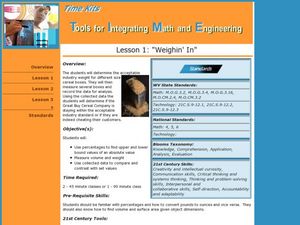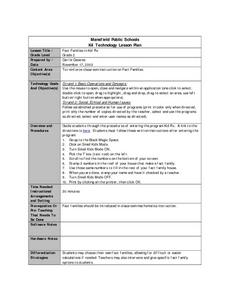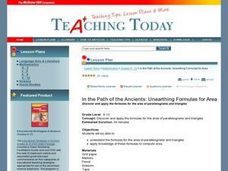Curated OER
Tools for Integrating Math and Engineering: Weighin' In
Students collect and analyze data on a fictional cereal company's products. In this measurement instructional activity, students collect data from cereal boxes (weight, volume, surface area, etc.) to determine if the boxes labels...
Curated OER
Underground Railroad
Students explore the Underground Railroad. In this U.S. history and technology activity, students research an assigned topic related to the Underground Railroad, such as "abolitionist," "conductor," or "station houses." ...
Curated OER
Aesop's Fables (Grade 3)
Third graders develop a presentation based on Aesop's Fables. For this Aesop Fables and presentation lesson, 3rd graders examine the characteristics of fables and how to interpret them. They choose one of Aesop's Fables to research. They...
Curated OER
Local Habitats
Students create dioramas that depict a habitat. In this habitat lesson, students use a variety of art items to develop either a marine, freshwater/pond, or forest habitat in a box. They write an expository essay about their habitat, and...
Curated OER
Middle Ages Timeline
Students research a historical figure from the Middle Ages. In this Middle Ages lesson, students present important events of their characters life and of the time. Students write a time card for each significant event. ...
Curated OER
Poetry and Visualization
Learners use visualization techniques when reading poetry. In this visualization and poetry lesson, students work in groups to present a tableau that depicts a word from the poem as classmates guess the word. Learners then...
Curated OER
Civil Rights/Segregation
Sixth graders investigate Civil Rights by participating in role-playing activities. In this U.S. History instructional activity, 6th graders research the history of slavery in order to portray a story through their debating and...
Curated OER
Tinker v. Des Moines (1969)
Students explore the concept of symbolic speech. In this case study instructional activity, students read excerpts of Tinker v. Des Moines. Students then complete the provided worksheet activities and determine whether they agree with...
Curated OER
Animal Coverings
Students read a book. In this animal characteristics lesson, students read the book Animal Coverings, answer comprehension questions, and complete a chart where they match animals with their coverings.
Curated OER
Electrifying Franklin
Fourth graders research and present information about Benjamin Franklin's life and accomplishments. In this lesson on Benjamin Franklin, 4th graders review idioms and sayings written by Franklin then compare and contrast his various...
Curated OER
Shoot for the Moon
Second graders distinguish the different phases of the moon. In this astronomy lesson, 2nd graders study the history of its discovery and myths about its origin. They simulate how the moon's surface is illuminated by the sun.
Curated OER
Myths and Legends on Natural Disasters: Making Sense of Our World
Students explore different natural and manmade disasters through a webquest. In this earth science lesson, students explain their causes. They also discuss how disasters affect society.
Curated OER
Mathematics Alive: Environment and Design of Human Habitats
Third graders explore the structural composition of buildings and houses. In this math lesson plan, 3rd graders explain how architecture is related to mathematics. They create a blueprint of a structure with at least three different spaces.
Curated OER
Art and Anatomy: The Vitruvian Teen
Twelfth graders create an artistic version of a Vetruvian teen. In this anatomy lesson, 12th graders design an experiment to test the theory of the ideally proportioned man. They present their findings in class.
Curated OER
Science Fiction Lesson Plans
Students can explore a literature genre through science fiction lesson plans.
Curated OER
Fact Families in Kid Pix
Second graders study Fact Families in Kid Pix. They use the mouse to open, close and navigate within this application. They assess one click to select, double click to open, drag to highlight, drag and drop, drag to select an area, use...
Curated OER
About The Author Lesson 4
Fourth graders engage in a lesson that continues the creation of a specialized Microsoft Word document. They practice creating art using Wordart and inserting images into the document with a paragraph attached. One of the main skills is...
Curated OER
People Of The Plains
Students engage in a lesson plan that discusses how Native Americans lived in all different parts of North America. They focus on investigating the region's natural resources and how the indians used them to build shelter, make clothing,...
Curated OER
Exploring Altitudes in Math
Students draw and calculate altitudes. They draw the altitude of acute, right and obtuse triangles and calculate the altitude of a triangle using the Pythagorean theorem.
Curated OER
In the Path of the Ancients: Unearthing Formulas for Area
Students apply the formulas for the area of parallelograms and triangles. Through guided practice, students discover the correct way to apply the formulas. Working in pairs, they write their own problems featuring the formulas.
Curated OER
Destination Investigation!
Students interpret a map or Atlas. They determine latitude, longitude, and absolute location and create and evaluate a travel itinerary. They identify the benefits and drawbacks of an itinerary and conduct online research as a means to...
Curated OER
What is Money? Learn the Role of Money in a Free Market System
Young scholars view a seashell and listen as the teacher explains that these were sometimes used as money. They listen as the teacher lectures on medium of exchange, barter, and commodity. Students determine the number of chickens it...
Curated OER
Money for starters
Students compare the values of coins and paper money. They read prices, read and write any 2-digit number. They model and explain addition calculations with a sum of up to 20.
Curated OER
Make a 100
Second graders develop an understanding of 100 and the quantity for which it stands and examine the relationship between 100 and 10 by estimating the number of jelly beans in a jar.

























